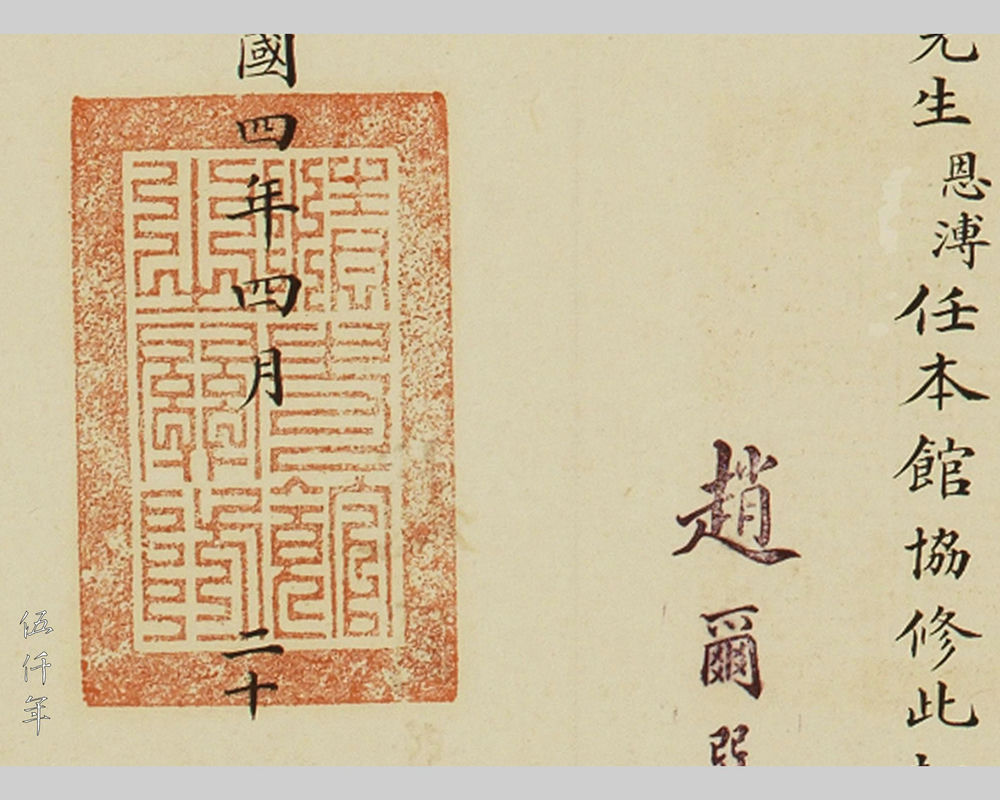
Detail of seal impression of the Bureau of Historia Ch’ing
After the dissolution of the Ch’ing dynasty, in the 3rd year of the Republic (1914), the State Council of the Republic of China petitioned to establish the Bureau of Historia Ch’ing, emulating the practices of the governments of both the Yuan dynasty and the Ming dynasty. The petition declared: “ And now that both state papers and manuscripts are intact, and documents have not been lost, it is only fitting to broadly summon the senior scholars, to open a grand Bureau, to assemble the finest humanities of an era, as verifications of credible history for posterity.” President Yüan Shih-k’ai (袁世凱) approved and instructed: “ Should immediately act according to the petition, establish the Bureau of Historia Ch’ing, invite and employ learned scholars, appoint them to the positions of compilers and editors, follow the previous examples of the Twenty Four Histories, and to complete the specialized books on the history of the last two hundred something years as trustworthy heritage.” Subsequently the Bureau of Historia Ch’ing was setup within the East Gate of the Forbidden City, and the former governor-general of Liaoning, Kirin and Heilungkiang provinces Chao Erh-hsün (趙爾巽) was appointed president of the Bureau.
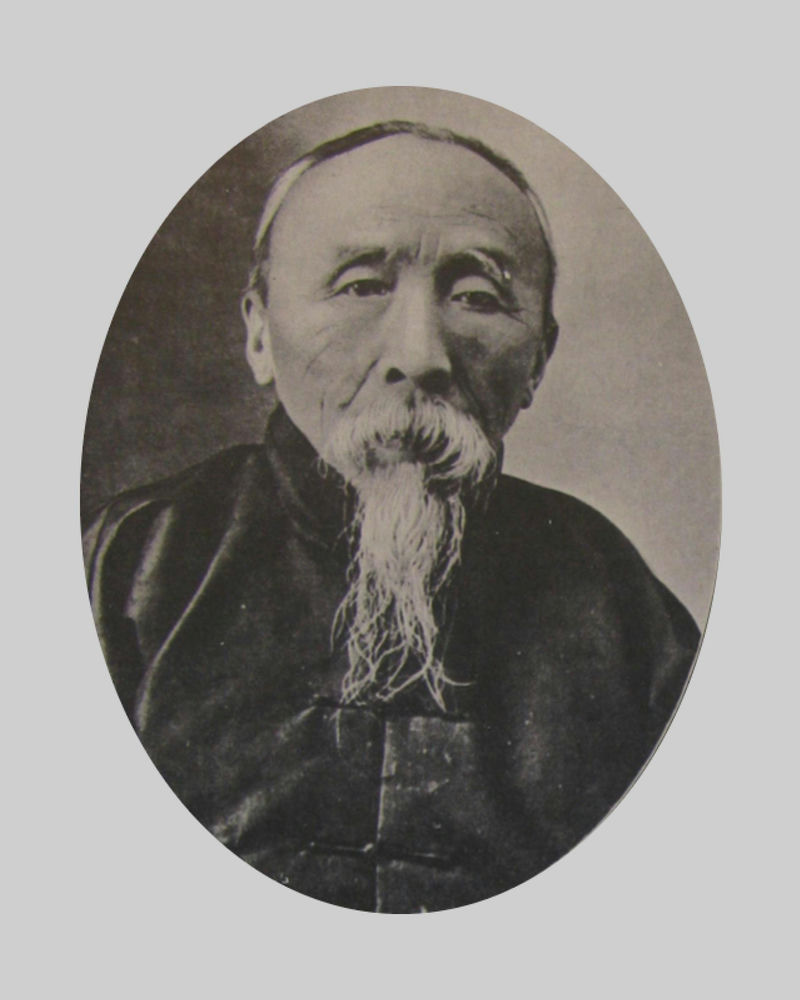
Portrait of Chao Erh-hsün, president of the Bureau of Historia Ch’ing. Photograph courtesy Wikipedia
Chao Erh-hsün (1844-1927), tzu Tz’u-shan, hao Kung-hsiang, Wu-pu, he was a native of T’ieh-ling, Feng-t’ien province ( Liaoning province), and belonged to the Han-Martial Plain Blue Banner. He attained the chin-shih degree in the 13th year of the T’ung-chih reign (1874), and was appointed compiler and editor of the Hanlin Academy. He held the successive positions as surveillance commissioner of Anhwei province, provincial administration commissioner of Sinkiang province, provincial administration commissioner of Shensi province, provincial governor of Shensi province, provincial governor of Hunan province, minister of the Ministry of Revenue, Sheng-ching General of Feng-t’ien province, governor-general of Hupeh and Hunan provinces, governor-general of Szechwan province, and governor-general of Liaoning, Kirin and Heilungkiang provinces. After the revolution, he was appointed president of the Bureau of Historia Ch’ing for thirteen years, and was the compiler and editor in chief of the Draft History of Ch’ing (清史稿). When Chang Hsün (張勳) attempted to restore the Manchu monarchy in the 6th year of the Republic (1917), Chao was appointed adviser and minister to Pi-te Yüan (Privy Council). After the Manchu Restoration failed, he was appointed president of the Rehabilitation Committee, and later president of the Provisional Political Participation Council.
Despite the establishment of the Bureau of Historia Ch’ing, the political situation remained conspiratorial and volatile, the works of compilation and editing, were exceedingly difficult and tortuous to carry through. In the 16th year of the Republic (1927), Chao Erh-hsün wrote the Foreword to the Publication of the Draft History of Ch’ing:
“In the beginning when the Bureau was launched, financing was still adequate, but from the 6th year of the Republic (1917) onwards, the government drastically reduced funding in the name of economic hardships. Especially in recent years funding has dried up, the deficit situation is too unbearable to recount in details. Senior men with influence rendered help and extended vocal support, money was advanced and borrowed till both means were exhausted. Light turned to darkness and the journey distant, the day of publication is almost unattainable.
………Erh-hsün has exerted heart and labor to the utmost, my old illness is fatal, in no time I have to bid farewell to you gentlemen, and my words fall short here.”
Chao Erh-hsün knew that he was like a flickering candle soon to be extinguished, in haste he wrote the foreword, and sought to swiftly publish the Draft. Regrettably reality and aspiration were contradictory, in that year he passed away. The first edition of the Draft History of Ch’ing was finally published and distributed in the following year.
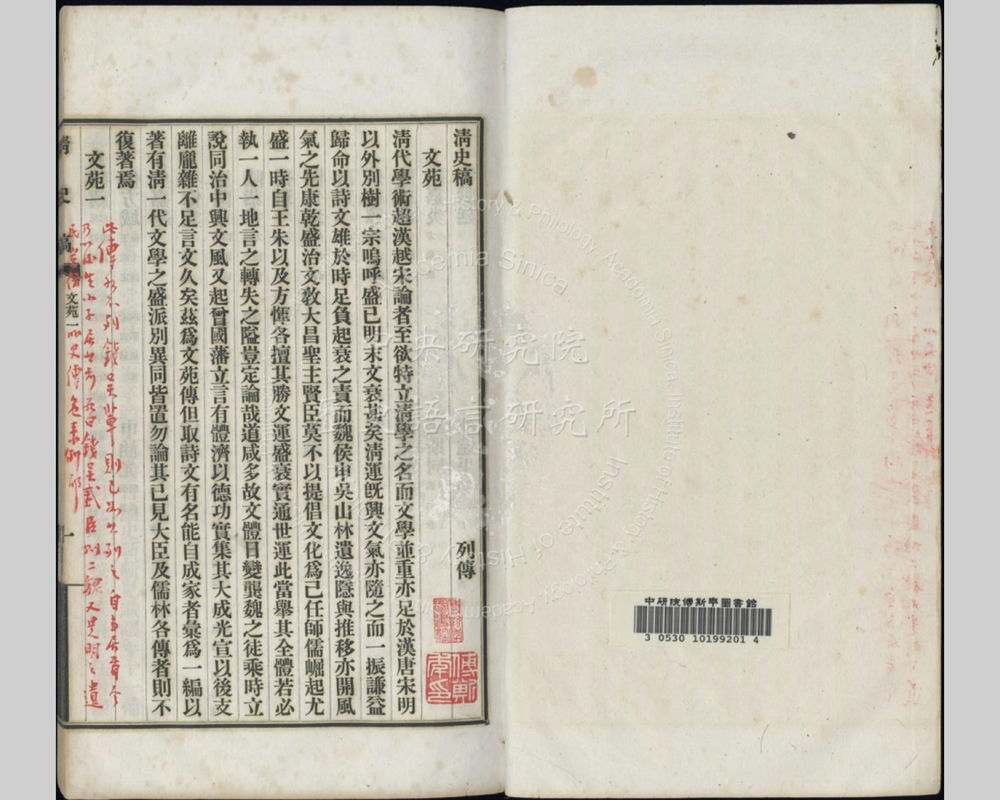
Inside page of the Draft History of Ch’ing, published in 1928, former collection of Fu Ssu-nien (傅斯年) . Photograph courtesy Academia Sinica
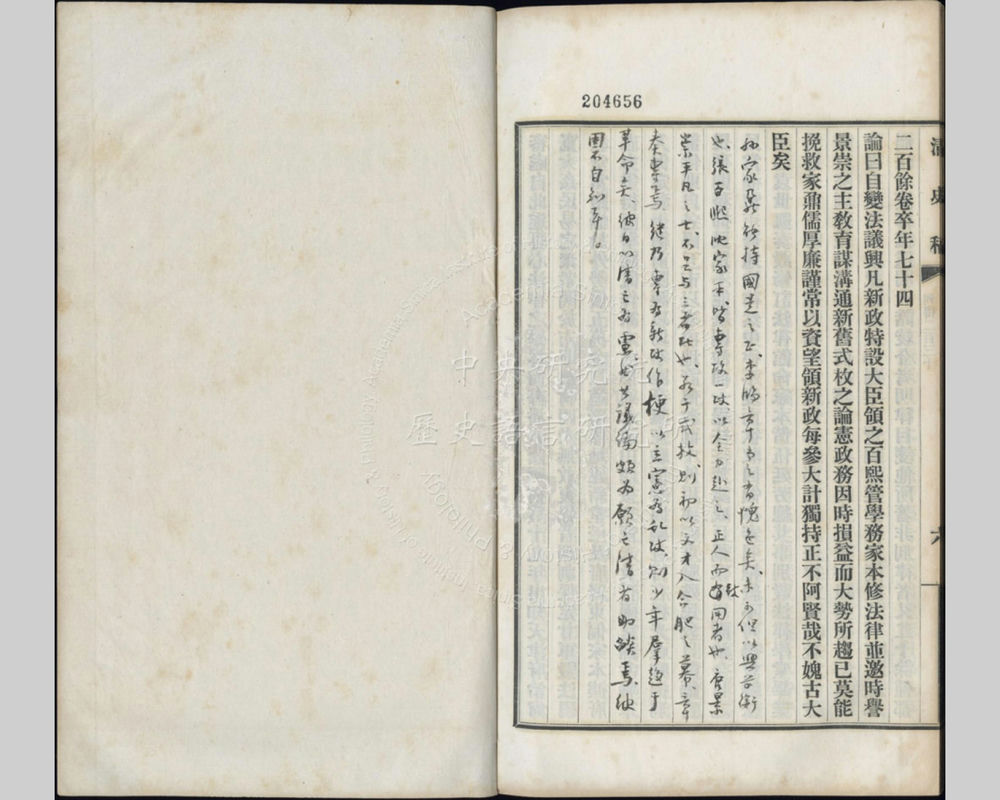
Inside page of the Draft History of Ch’ing, published in 1928, former collection of Fu Ssu-nien (傅斯年) . Photograph courtesy Academia Sinica
The organization structure of the Bureau encompassed president, chief editors, editors, assistant editors, proofreaders, controllers and dispatchers. They were indeed a selection of the finest scholars of the time, adding up to one hundred and two scores, furthermore they were mostly former officials or i-min of Ch’ing dynasty.
The chief editors included Shen Tseng-chih (沈曾值 1850-1922), Fan Tseng-hsiang (樊增祥 1846-1931), Mou Ch’üan-sun (繆荃孫 1844-1919), Ma Ch’i-ch’ang (馬其昶 1855-1930), editors included Wu Shih-chien (吳士鑑 1868-1934), Li Jui-ch’ing (李瑞清 1867-1929), Yang Chung-hsi (楊鍾羲 1865-1940), Yüan Li-chun (袁勵準 1881-1935), assistant editors included Li Pao-hsün (李葆恂 1859-1915), Yü Pi-yün (俞陛雲 1868-1950), Lo Tun-jung (羅惇曧 1872-1924), Chang Erh-t’ien (張爾田 1874-1945). These were all scholars admired for their learnings throughout the land.
In the 4th year of the Republic (1915), Chao Erh-hsün invited T’ang En-p’u (唐恩溥) to take on the assignment of assistant editor, in the 5th year of the Republic (1916), T’ang moved to Peking to undertake the commission, and in the 6th year of the Republic (1917), his appointment was changed to the position of editor. It is now impossible to examine which volume or chapter of the Draft History of Ch’ing did his tenure entail. All we are now left with are these two Letters of Appointments, from which it is still possible to gauge the format of such document and letter from the Bureau of Historia Ch’ing. The personnel of the Bureau numbered one hundred and two scores, after waves of mayhems in modern history, how many of these families might have managed to retain such Letters of Appointments? They are slight and insubstantial items, but they are distant reminders of those scholars from the past, lonesome yet assiduous, who conceived the monumental mission to leave credible history for posterity.
Letter of Appointment to the Position of Assistant Editor from the Bureau of Historia Ch’ing, Signed by Chao Erh-hsün
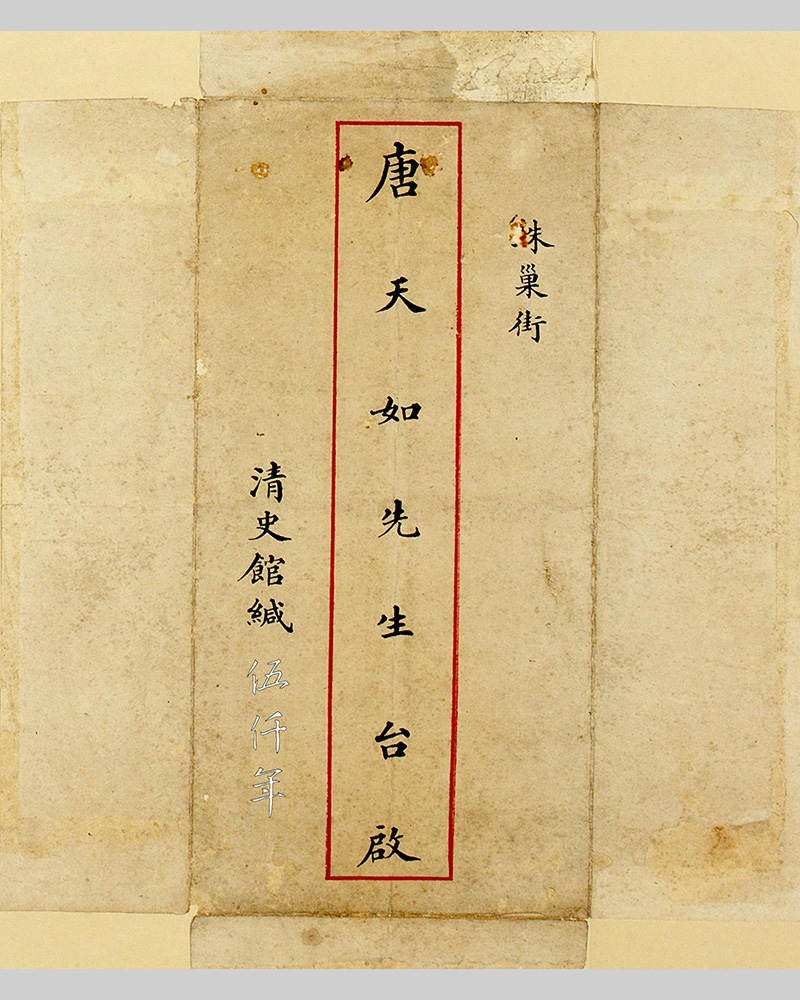
Envelope of Letter of Appointment to the position of assistant editor from the Bureau of Historia Ch’ing.The Studio of Prunus Ode Collection
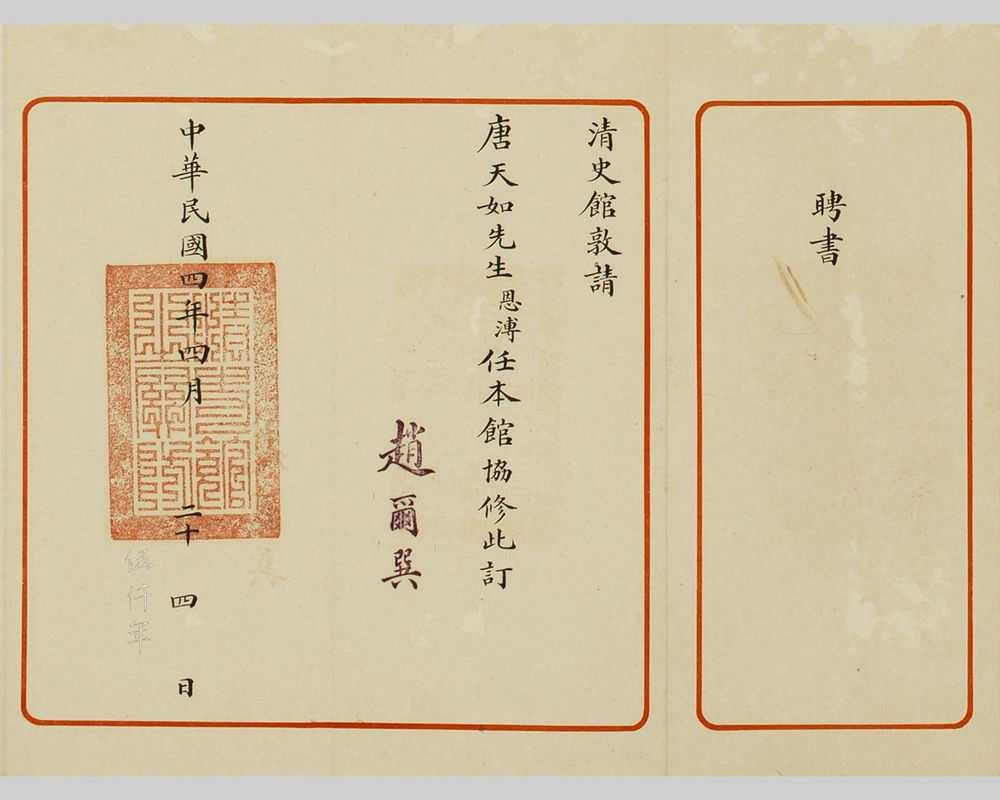
Letter of Appointment to the position of assistant editor from the Bureau of Historia Ch’ing. The Studio of Prunus Ode Collection
Dated 24th April, the 4th year of the Republic (1915)
Ink on paper
Signed: Chao Erh-hsün
Seal impression: The Official Seal of the Bureau of Historia Ch’ing
Letter of Appointment to the Position of Editor from the Bureau of Historia Ch’ing, Signed by Chao Erh-hsün
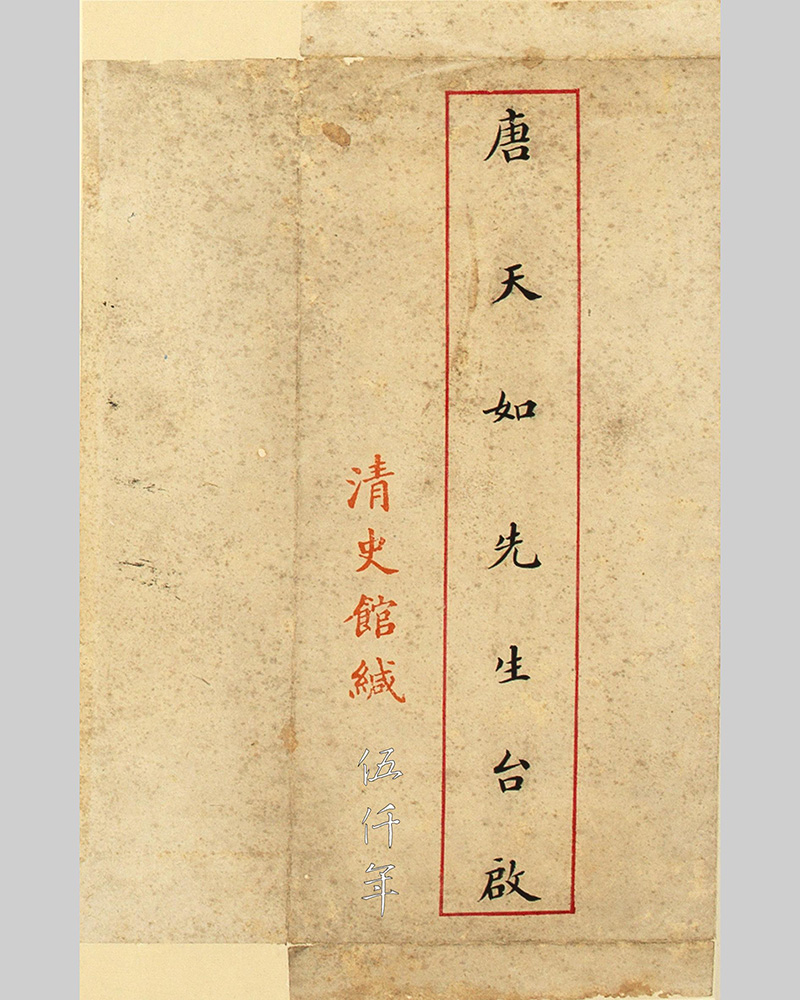
Envelope of Letter of Appointment to the position of editor from the Bureau of Historia Ch’ing. The Studio of Prunus Ode Collection
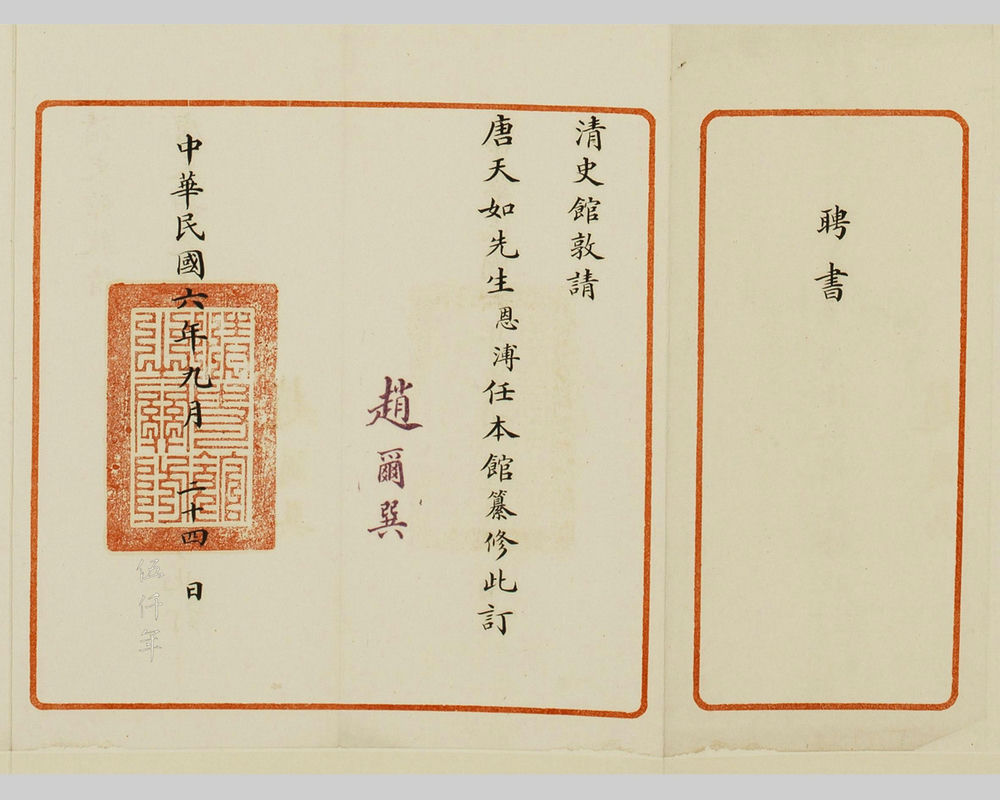
Letter of Appointment to the position of editor from the Bureau of Historia Ch’ing. The Studio of Prunus Ode Collection
Dated 24th September, the 6th year of the Republic (1917)
Ink on paper
Signed: Chao Erh-hsün
Seal impression: The Official Seal of the Bureau of Historia Ch’ing
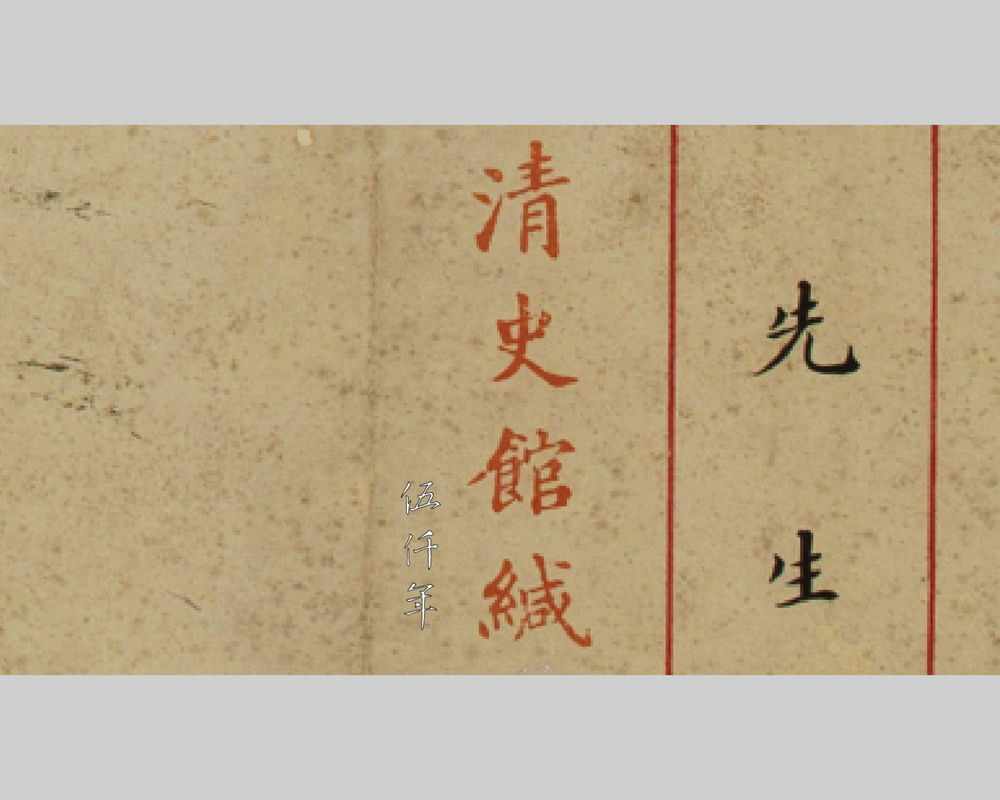
Envelope detail of Letter of Appointment from the Bureau of Historia Ch’ing




